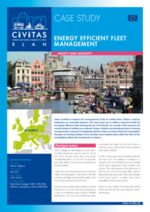Energy management of public fleets
Thematic areas
Clean & energy-efficient vehicles
Summary
Just replacing some standard vehicles with clean ones will not be enough to initiate a radical new approach to the energy use of public fleets. The CIVITAS ELAN worked together in a joint action on the best strategies, with each choosing a dedicated energy manager.
Implementing sustainable mobility
Clean and efficient vehicles are a central part of the CIVITAS demonstrations. This joint action allowed each city to establish an overview on the energy consumption of the municipal and city fleets to be considered and a matrix for assessing them. The energy manager also planned a number of trainings and dissemination workshops. The main objectives was to introduce clean fleet vehicles and sustainable fleet management for city administration and public operators in support of local air quality objectives within each of the CIVITAS-ELAN cities and to follow the most recent developments on the theme of biofuels and to spread this information to the ELAN partners.
Progress
During the implementation phase the energy managers assessed, according to the matrix already developed, the respective fleets of the CIVITAS ELAN cities, coordinated cooperation among them and organised workshops for the dissemination of the results. The results were used to draw recommendations on how to further improve the energy efficiency of the fleets analysed throughout CIVITAS ELAN.
In this measure all cities will worked together on the following issues:
- Overview of technologies for vehicles operational feasible for real public fleets;
- Common specifications for these type of vehicles;
- Financial issues (taxes, financial impacts);
- Strategies and learning programmes on ecological driving approaches;
- Management strategies for integrated usage of the fleets to minimise the number of vehicles and optimise the quality.
Outcomes
Ghent expects the measure will:
- Reduce the number of cars in the city fleet;
- Reduce car use;
- Reduce costs because of the reduction in fuel use;
- Reduce CO2 and dust emissions;
- Decrease the number of accidents because of a larger follower distance and less abrupt pulling up and braking;
- Promote energy friendly driving behaviour.








